Mona Lisa replicas and reinterpretations
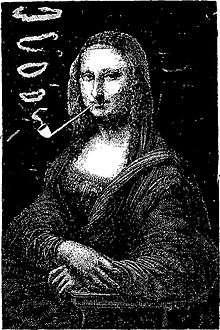


Leonardo da Vinci's Mona Lisa is one of the most recognizable and famous works of art in the world, and also one of the most replicated and reinterpreted. Mona Lisa replicas were already being painted during Leonardo's lifetime by his own students and contemporaries. Some are claimed to be the work of Leonardo himself, and remain disputed by scholars. Prominent 20th-century artists such as Marcel Duchamp and Salvador Dalí have also produced derivative works, manipulating Mona Lisa's image to suit their own aesthetic. Replicating Renaissance masterpieces continues to be a way for aspiring artists to perfect their painting techniques and prove their skills.[1]
Contemporary Mona Lisa replicas are often created in conjunction with events or exhibitions related to Leonardo da Vinci, for publicity. Her portrait, considered public domain and therefore outside of copyright protection, has also been exploited to make political statements. Known even to people with no art background, the mere use of Mona Lisa's name – immortalized in Academy Award-winning lyrics sung by Nat King Cole (Best Original Song, 1950) – is capable of stirring public interest and intrigue.[2] Aside from countless print-reproductions of Leonardo's original Mona Lisa on postcards, coffee mugs and T-shirts, her likeness has also been re-imagined using coffee, toast, seaweed, Rubik's Cubes, and computer chips, to name only a few. Now over five-hundred years since her creation, the perpetuation of Mona Lisa's influence is reinforced with every reinterpretation.[2]
Background
At the start of the 16th century, Leonardo da Vinci was commissioned by Florentine nobleman Francesco del Giocondo to paint a portrait of his wife, Lisa.[3] The painting is believed to have been undertaken between 1503 and 1506.[4] Leonardo's portrait of Mona Lisa ("Mona" or "Monna" being the Italian honorific for "Madame") has been on display as part of the permanent collection at Paris' Louvre museum since 1797. It is also known as La Joconde in French and La Gioconda in Italian,[3][5] and has been known by other names in the past. There is a new study setting the beginning of the Mona Lisa to an earlier date that thought before, pre-1478, contrary to Vasari's narrative.[6] Replicas of Mona Lisa date back to the 16th century,[4] including sculptures and etchings inspired by the painting.[7][8] But even by the start of the 20th century, historian Donald Sassoon has stated, Mona Lisa was still "just a well-respected painting by a famous old master, hanging in one of the great museums of the world."[2] The image had yet to gain iconic status, and, Sassoon adds, was "not even the most valued painting in the Louvre."[2] The painting's theft on August 11, 1911, and the subsequent media frenzy surrounding the investigation and its recovery are contributing factors which ignited public interest and catapulted Mona Lisa to its current standing.[2]
Mona Lisa is considered public domain and free to be exploited, explaining its reproduction on everything from postcards to coffee mugs, with no legal repercussions. Artistic replicas and reinterpretations as a whole – demonstrating adequate modification – are considered new works eligible for copyright protection. A fine example is artist Marcel Duchamp's L.H.O.O.Q., a work of art in which Duchamp embellished existing print-reproductions of Leonardo's Mona Lisa by merely adding a goatee (shown below).[9] While copyright laws do not protect Leonardo's Mona Lisa, Duchamp's L.H.O.O.Q. falls within parameters of copyright law constituting new works. For such reasons, Mona Lisa is commonly referenced academically in copyright courses.[10]

.jpg)
Isleworth Mona Lisa
Tests conducted in 2012 fed speculation that a painting unveiled in Switzerland, touted as the "original" Mona Lisa, may in fact be the work of Leonardo himself. The painting, known as the "Isleworth Mona Lisa" for the London suburb where it surfaced (shown near right), has long-been disputed by experts; some claim it to be a late 16th-century replica. Results of carbon-dating tests done by the Swiss Federal Institute of Technology in Zürich indicate that the canvas on which it is painted dates from between 1410 and 1455, more than a half-century earlier than the Louvre's Mona Lisa. But media coverage often fails to note that Mona Lisa, as all of Leonardo's work, is known to have been painted on wood. Representatives of the Mona Lisa Foundation, which champions the painting as a Leonardo original, also cited other mathematical tests corresponding to the kind of sacred geometry sometimes identified with works such as Leonardo's Vitruvian Man. Analysis of brush strokes led some to conclude that the Isleworth painting and the Louvre's Mona Lisa may have been executed by the same hand,[3] but Leonardo experts point to infrared analysis which contradict such claims and the painting remains a subject of debate. The painting is now in a private collection.[11]
Prado Mona Lisa
In 2011, the Prado museum in Madrid, Spain, announced discovery of what may be the earliest known replica.[4][12] Miguel Falomir, heading the Department of Italian Renaissance Painting at the time of the discovery, stated the Prado "had no idea of (the painting's) significance" until a recent restoration.[4] Recovered from the Prado's vaults, the replica – which El Mundo newspaper dubbed "Mona Lisa's twin" (above, far right)[12] – was reportedly painted simultaneously alongside Leonardo as he painted his own Mona Lisa; in the same studio, by a "key" student.[4] It was painted on walnut. The replica has been part of the Prado's collection since the museum's founding in 1819.[13]
After restoration, the Prado's Mona Lisa revealed details covered by previous restorations and layers of varnish. Furnishings and fabrics were enhanced, as well as landscape and facial features. It is anticipated that such revelations may offer further insight into Leonardo's original. Experts at the Louvre reportedly supported the Prado museum's findings. The Prado replica was subsequently transported to the Louvre in 2012 to be displayed next to Mona Lisa as part of a temporary exhibition.[4][12][13]
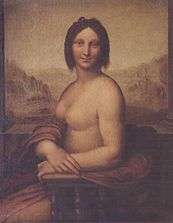
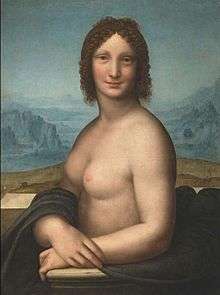
Mona Vanna
Two nude paintings bearing similarities to Leonardo da Vinci's original were part of a 2009 exhibition of artwork inspired by Mona Lisa. Displayed at the Museo Ideale in Leonardo's hometown of Vinci, near Florence, some believe one of the paintings – dating from Leonardo's time[7] – to be the work of Leonardo himself, and it has at times been credited to him.[14] Other experts theorize the painting, one of at least six known to exist, may be just another copy painted by "followers" of Leonardo. Scholarly dispute persists as to artist, subject and origin.[15] The nude in question, discovered behind a wall in a private library, reportedly belonged to an uncle of Napoleon Bonaparte, who owned another of Leonardo's paintings.[7] Facial features bear only vague resemblance, but landscape, compositional and technical details correspond to those of the Mona Lisa known worldwide today.[14][15]

A student and companion of Leonardo da Vinci known as Salaì painted one of the nude interpretations of Mona Lisa known, titled Mona Vanna. Salai's version is thought by some to have been "based on" the nude sometimes attributed to Leonardo, which is considered a lost work. Discussion among experts exists as to whether Salai, known to have modeled for Leonardo, may in fact have been the sitter represented in the original Mona Lisa.[16][17]
Joos van Cleve, a Flemish artist active in the years following Mona Lisa's creation, also painted a nude titled Mona Vanna. Though the figure portrayed in van Cleve's painting bears no resemblance to Leonardo's Mona Lisa, the artist was known to mimic themes and techniques of Leonardo da Vinci, in this case the positioning of the figure and the delicate brushwork reminiscent of Leonardo's sfumato. The artwork, dating to the mid-16th century, is in the collection of the National Gallery, Prague.[18]
20th century
By the 20th century, Mona Lisa had already been a victim of satirical embellishment. Sapeck (Eugène Bataille), in 1883, depicted Mona Lisa smoking a pipe (shown above). Titled Le Rire (The Laugh), the artwork was displayed at the "Incoherents" exhibition in Paris at the time of its creation, making it among the earliest known instances of Mona Lisa's image being re-interpreted using contemporary irony. Further interpretations by avante garde artists beginning in the early 20th century, coinciding with the artwork's theft, attest to Mona Lisa's popularity as an irresistible target. Dadaists and Surrealists were quick to modify, embellish and caricature Mona Lisa's visage.
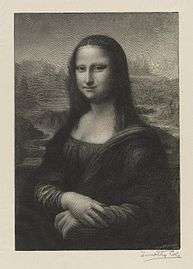
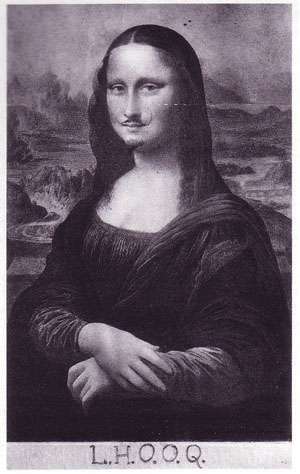
L.H.O.O.Q.
Marcel Duchamp, among the most influential artists of his generation, in 1919 may have inadvertently set the standard for modern manifestations of Mona Lisa simply by adding a goatee to an existing postcard print of Leonardo's original. Duchamp pioneered the concept of readymades, which involves taking mundane objects not generally considered to be art and transforming them artistically, sometimes by simply renaming them and placing them in a gallery setting. In L.H.O.O.Q. the "found object" is a Mona Lisa postcard onto which Duchamp drew a goatee in pencil and appended the title.
The title, Duchamp is said to have admitted in his later years, is a pun. The letters L-H-O-O-Q pronounced in French form the sentence Elle a chaud au cul, colloquially translating into English as "She has a hot ass."[19] As was the case with many of his readymades, Duchamp made multiple versions of L.H.O.O.Q. in varying sizes and media throughout his career. An unmodified black and white reproduction of Mona Lisa on a playing-card, onto which Duchamp in 1965 inscribed LHOOQ rasée (LHOOQ Shaved), is among many second-generation variants referencing the original L.H.O.O.Q.[20]
Duchamp's parody of Mona Lisa was itself parodied by Francis Picabia in 1942, annotated Tableau Dada Par Marcel Duchamp ("Dadaist Scene for Marcel Duchamp"),[21] another example of second-generation interpretations of Mona Lisa. Salvador Dalí created his Self Portrait as Mona Lisa in 1954, referencing L.H.O.O.Q. in collaboration with Philippe Halsman, incorporating his photographs of a wild-eyed Dalí showing his handlebar moustache and a handful of coins.[2][21][22] In 1958, Icelandic painter Erró then incorporated Dalí's version into a composition which also included a film-still from Dalí's Un Chien Andalou. Fernand Léger and René Magritte are among the numbers of Modern art masters who've adapted Mona Lisa using their own iconography.[2] None of the parodies have tarnished Mona Lisa's image; rather, they reinforce her fame.[2] Duchamp's mustached Mona Lisa embellishment continues to inspire imitation. Contemporary conceptual artist Subodh Gupta gave L.H.O.O.Q. three-dimensional form in his 2009 bronze sculpture Et tu, Duchamp? Gupta, from India, considers himself an "idol thief" and has reinterpreted a number of iconic works from European art history.[23]
Post-tour years (1962–2000)
Radio personality Cousin Brucie Morrow presided over a promotional event during Mona Lisa's exhibition in New York City. 70,000 entries of a "Best Mona" painting contest were exhibited at the Polo Grounds, with Salvador Dalí helping to pick the winner.[24] Following the painting's first American presentation, Andy Warhol in 1963 created multiple renditions in his screen-print Pop art style. [25] "Mona Lisa (Two Times)," "Four Mona Lisas," and "Thirty Are Better Than One" illustrate Warhol's method of silkscreening an image repetitively within the same work of art. Also in 1963, Fernando Botero – who had already painted "Mona Lisa, Age Twelve" in 1959 – painted another, this time in what would become his trademark "Boterismo" style of rendering figures disproportionately plump. Mona Lisa is also referenced in artwork by Contemporary art luminaries such as Jasper Johns and Robert Rauschenberg, adding to the veritable "who's who" list of artists putting their own spin on the portrait.[2]
.jpg)
A paint by numbers version of Mona Lisa accompanied artist Suzanne Lacy during her 1977 travelogue Travels with Mona, documenting the painting process at landmark locations throughout Europe and Central America.[21] From the 1980s through the end of the 20th Century, Mona Lisa continued to be the subject of re-interpretation among a new generation of emerging artists. Street artists such as Jean-Michel Basquiat and Keith Haring, who came into prominence in the 1980s, created "Federal Reserve Note" and "Apocalipse 7", respectively, juxtaposing Mona Lisa within compositions suiting their styles. Ballpoint art pioneer Lennie Mace created his "Mona a'la Mace" replica in 1993, a ballpoint "PENting" commissioned by Pilot pen company and featured on CBS News.[26][27] Artist Sophie Matisse, great-granddaughter of artist Henri Matisse, in her 1997 "Monna Lisa (Be Back in Five Minutes)" faithfully replicated the setting of the original painting, but omitted Mona Lisa from the scene; a concept she would repeat using other iconic artworks.[28]
21st century
British street artist Banksy in the first decade of the 21st century stenciled a "Mona Lisa Mujaheddin" holding a rocket launcher, and another mooning the viewer.
Contemporary commercialization
Mona Lisa's iconic face has been available for years in all forms, reproduced on everything from birthday cards to refrigerator magnets,[29] appearing in advertisements for fashion and travel industries, and on the cover of magazines.[2] Leonardo da Vinci's own status as genius has been suggested as a factor contributing to the mystique of his creation.[30] The eyes of Leonardo's original Mona Lisa appear within cover-graphics for Dan Brown's fictional novel The Da Vinci Code.[2] The Mona Lisa portrait also appeared in the teaser trailer for the 2006 film of the same name, although a replica was used for filming, appears only briefly in the film, and plays a very small part in the story. Along with Vermeer's Girl with a Pearl Earring, Mona Lisa is among the most replicated works of art. The sheer number and variety of replicas and reproductions since its creation in the early 16th century illustrates a so-called self-reinforcing dynamic; utilized in advertising because of its familiarity, thereby re-enforcing its fame.[2]
Painting knock-offs of Mona Lisa and other Western masterpieces has become a cottage industry of sorts. Struggling artists in China paint them by the hundreds to supply the demand of American and European markets, and Mona Lisa is among the most popular requests. Working in cramped studios, or at home with children running around, these artists can earn a few hundred dollars (US) for a weeks worth of work on paintings which are then sold retail through mail-order catalogues.[1] Reproducing the works of old masters by hand not only provides a way to earn a living but also a way of furthering their art education by perfecting painting techniques.[1]
Among the most common motifs for satirization, Mona Lisa's face is embellished upon; adding a red Santa cap for Christmas,[31] or, as Duchamp had done, simply adding a mustache. Replacing Mona Lisa's face or head altogether is another common motif; substituting the head of an animated character such as Betty Boop, for example.[29] British artist Caroline Shotton in 2007 produced a series of paintings replicating classical works of art as cows, which she would go on to title her "Great Moo-sters" series. The inspiration for the series, she says, came to her while watching a documentary about Mona Lisa. Having settled upon the cow motif, she then formulated puns befitting her chosen subjects; whereby Mona Lisa became Moo-na Lisa.[32]
In a film called Elf, Buddy uses an Etch-a-Sketch to draw the Mona Lisa in process to build Santa Land by the North Pole in Gimbels. In Horton Hears A Who, the Mayor Ned McDodd shows his only son Jojo a family gallery where in one part his great grandmother is parodied as the Mona Lisa. And in My Little Pony: Equestria Girls – Friendship Games, there is a cake that Pinkie Pie and Fluttershy have baked with a picture of the Mona Lisa inside.
Unconventional interpretations
Mona Lisa replicas are sometimes directly or indirectly embellished as commentary of contemporary events. Exhibitions or events with ties to Leonardo da Vinci or Renaissance art also provide an opportunity for local artists to exploit Mona Lisa's image toward promoting the events.[30] The resulting artworks represent a broad spectrum of artists using creative license.
In 2009, a replica of Mona Lisa was pieced-together using precious gemstones by a jewelry collector in China. Using approximately 100,000 carats of multi-colored jewels amassed over 30 years, the replica required five years to complete. The resulting artwork was publicly displayed at a Shenyang City shopping center.[33] In a similar vein, artist Kristen Cumings in 2010 created her own "Jelly Bean Mona" replica using over 10,000 jelly beans. The one initial creation led to a full series of eight masterpiece replicas commissioned by a California jelly bean company as a publicity stunt and addition to the company's collection. Ohio's Center of Science and Industry (COSI) in Columbus thought the series noteworthy enough to be featured in an exhibition, held at the end of 2012.[34]
A replica of Mona Lisa publicized as the "world's smallest" was painted by Andrew Nichols of New Hampshire (USA) in 2011, intending "to break the record." Recreated at a 70:1 ratio, the miniature Mona Lisa measures approximately 1/4 by 7/16 inches (7 by 11 mm). Although his rendition drew media attention, it was never officially reported whether he had, in fact, broken any existing record. In 2013, a far smaller version of the painting, entitled the Mini Lisa, was created by a Georgia Institute of Technology student named Keith Carroll. The replica was created to demonstrate a new scientific technique called thermochemical nanolithography (TCNL). The Mini Lisa was just 30 micrometres (0.0012 in) wide, about 1/25,000th the size of the original.[35]
High school students attracted media attention in 2011 by recreating Mona Lisa on Daytona Beach, Florida (USA), using seaweed which had accumulated on shore. Claiming to have "too much time on their hands," it took two people approximately one hour to "turn the ugly seaweed into a work of art." Aside from photos appearing in the press, presumably their efforts were washed away with the tide.[36]
In 2012 the Portuguese designer Luís Silva created a poster for a campaign against violence on women representing Mona Lisa with a sore eye and a sombre expression, with the slogan "Could you live without her smile?".[37]
Mosaics
The computer age introduced digitally-produced or -inspired incarnations of Mona Lisa. Aside from versions constructed of actual computer motherboards,[38] mosaic-making techniques are another common motif used in such re-creations.[34]
A photo mosaic of Mona Lisa was digitally produced in 2012 from randomly compiled photos using adaptive rendering software,[39] to promote the potential of Simultaneous Multi-compare Adaptive Rendering Technology (SMART), which automatically analyzes and matches the shapes and colors of source-photos to a desired image.[40]
Mimicking the heavy pixelation of a highly magnified computer file, Canadian artist Robert McKinnon assembled 315 Rubik's Cubes into a 36 by 48 inch Mona Lisa mosaic, an effect dubbed "Rubik's Cubism" by French artist Invader.[41] Similarly, colored Lego bricks have been employed to replicate Mona Lisa in a mosaic motif. A 2011 exhibition titled Da Vinci, The Genius at the Frazier Museum in Louisville, Kentucky attracted attention by having a Mona Lisa constructed by Lego artist Brian Korte.[30] Known as Brick Art, so-called "pro" Lego builders such as Eric Harshbarger have made multiple replicas of Mona Lisa. Matching the approximate 21 by 30 inch size (535 x 760+ mm) of Leonardo's original[5] requires upwards of 5,000 standard Lego bricks, but replicas measuring 6 by 8 feet have been built, requiring more than 30,000 bricks.[42][43][44]
At a 2009 festival in Sydney, Australia, a group of eight people spent three hours creating a Mona Lisa replica from 3,604 cups of coffee. The mosaic effect in this case was created by adding amounts of milk, or sometimes none, to cups of black coffee. The final product, measuring 20 by 13 feet, was dubbed the "Mocha Lisa."[45][46] Maurice "Toastman" Bennet, known for recreating masterpieces using toasted bread, parodied Mona Lisa in a toast mosaic. At a 2010 food-art festival in Hong Kong, Bennet tiled together approximately 6,000 slices of bread, using a blow-torch to achieve the desired tone on each piece of toast.[47]
Media coverage of the many incarnations of Mona Lisa often allude to the likely disbelief of Leonardo himself; of the intrigue she would come to inspire, and the unimaginable extremes of her re-portrayal.[38]
| “ | "Are you warm, are you real, Monalisa? Or just a cold and lonely, lovely work of art?'" ("Mona Lisa" as sung by Nat King Cole, 1950; Lyrics by Jay Livingston, Ray Evans.[48]) | ” |
See also
References
- 1 2 3 WuDunn, Sheryl (October 29, 1989). "What Lies Behind The Strange Smile On the Mona Lisa". nytimes.com. Retrieved February 2013. Check date values in:
|access-date=(help) - 1 2 3 4 5 6 7 8 9 10 11 12 Peter Hedstrom,, Peter Bearman (2009). The Oxford Handbook of Analytical Sociology. USA: Oxford University Press. ISBN 9780191615238. Retrieved August 2012. Check date values in:
|access-date=(help) - 1 2 3 staff writer, uncredited (2013). "Fresh proof found for the 'original' Mona Lisa". Microsoft. Retrieved February 2013. Check date values in:
|access-date=(help) - 1 2 3 4 5 6 "Spain's Prado Museum claims to have Mona Lisa copy". perhaps earliest. Herald Sun. February 3, 2012. Retrieved February 2013. Check date values in:
|access-date=(help) - 1 2 Hoobler, Dorothy & Thomas (May 2009). "Stealing Mona Lisa". excerpt of book. Vanity Fair. Retrieved February 2013. Check date values in:
|access-date=(help) - ↑ http://beyondthirtynine.com/leonardos-mona-lisa-was-painted-in-1478-not-in-1504-nor-in-1514/
- 1 2 3 staff writer, uncredited (June 13, 2009). "Nude Mona Lisa To Be Displayed At Exhibition In Italy". redOrbit.com. Retrieved February 2013. Check date values in:
|access-date=(help) - ↑ Zollner, Frank (2000). Leonardo Da Vinci: 1452-1519. illus: Raphael visiting Leonardo. Taschen. ISBN 3-8228-5979-6. Retrieved March 2013. Check date values in:
|access-date=(help) - ↑ staff writer, uncredited. "Copyright & Fair Use". Stanford University Libraries (SU LAIR). Retrieved February 2013. Check date values in:
|access-date=(help) - ↑ "Copyrighting Right". How to avoid copyright violations in scientific presentations and on the Web. The NIH Catalyst. Sep–Oct 2008. Retrieved February 2013. Check date values in:
|access-date=(help) - ↑ Keaten, Jamey (September 26, 2012). "Group claims Da Vinci painted early Mona Lisa". Isleworth Mona Lisa. USA Today, Gannet Co. Inc. Retrieved March 2013. Check date values in:
|access-date=(help) - 1 2 3 "Earliest Mona Lisa claimed by Spanish museum". CBS news. February 1, 2012. Retrieved February 2013. Check date values in:
|access-date=(help) - 1 2 "Mona Lisa Prado museum version on display". oldest Mona Lisa replica. Telegraph Media Group Ltd. February 21, 2012. Retrieved March 2013. Check date values in:
|access-date=(help) - 1 2 staff writer, uncredited (2011). "Nude Mona Lisa-Like Painting Found". TheHuffingtonPost.com, Inc. Retrieved February 2013. Check date values in:
|access-date=(help) - 1 2 staff writer, uncredited (June 15, 2009). "Mona Lisa' in the nude?". Work that resembles Leonardo da Vinci's masterpiece on display. Daily News online. Retrieved February 2013. Check date values in:
|access-date=(help) - ↑ "Mona Lisa model was male". ABC news. February 3, 2011. Retrieved March 2013. Check date values in:
|access-date=(help) - ↑ "Odd News". Da Vinci painted nude Mona Lisa. UPI. November 16, 2009. Retrieved March 2013. Check date values in:
|access-date=(help) - ↑ "Joos van Cleve". artist bio database. Web Gallery of Art. Retrieved March 2013. Check date values in:
|access-date=(help) - ↑ Seekamp, Kristina (2004). "Unmaking the Museum: Marcel Duchamp's Readymades in Context". Binghamton University Department of Art History. Archived from the original on 17 October 2007. Retrieved September 12, 2006.
- ↑ De Marting, Marco (2003). "Mona Lisa: Who is Hidden Behind the Woman with the Mustache?". LHOOQ. Art Science Research Laboratory.
- 1 2 3 Irish, Sharon (2010). Suzanne Lacy: Spaces Between. Minnesota: University of Minnesota Press. pp. 67, 68. ISBN 978-0-8166-6095-7. Retrieved August 2012. Check date values in:
|access-date=(help) - ↑ Baron, Robert A. (1973). "Mona Lisa Images for a Modern World". exhibition catalogue. Museum of Modern Art. Retrieved October 2009. Check date values in:
|access-date=(help) - ↑ "Et tu, Duchamp?". installation. Mor Buro. Retrieved March 2013. Check date values in:
|access-date=(help) - ↑ Boehlert, Eric (4 July 1992). "Top 40 (radio programming) Pioneer Rick Sklar Dies After Surgery". Billboard magazine. Manhattan, New York, USA: 76. Retrieved August 2012. Check date values in:
|access-date=(help) - ↑ Sassoon, Donald (2003). Becoming Mona Lisa. Harvest Books via Amazon Search Inside. p. 251. ISBN 0-15-602711-9.
- ↑ Liddell, C.B. (April 3, 2002). "The hair-raising art of Lennie Mace; Lennie Mace Museum". The Japan Times. Tokyo, Japan: Times Ltd. ISSN 0447-5763. OCLC 21225620. Retrieved May 2012. Check date values in:
|access-date=(help) - ↑ CBS Evening News; "Macedonia" exhibition preview, Lennie Mace interview; segment producer & interviewer Morry Alter; November 10, 1993
- ↑ Wong, Sherry (January 2002). "Back in Five Minutes". Sophie Matisse exhibition preview. art net.com. Retrieved April 2013. Check date values in:
|access-date=(help) - 1 2 "Mona Lisa with Betty Boop head". refrigerator magnets. Sunset Key Chains. Retrieved March 2013. Check date values in:
|access-date=(help) - 1 2 3 "Mona Lisa Replica Being Built in Louisville". Gray Television, Inc. Aug 25, 2011. Retrieved March 2013. Check date values in:
|access-date=(help) - ↑ "Mona Lisa with Santa cap". t-shirts. dazzle. Retrieved March 2013. Check date values in:
|access-date=(help) - ↑ "The art cow-lection worth L3million". Mona Lisa as a Cow. Associated Newspapers Ltd. November 26, 2007. Retrieved March 2013. Check date values in:
|access-date=(help) - ↑ staff writer, uncredited (March 2009). "Mona Lisa made of 100,000 carats of jewelry". Mona Lisa on display at Chinese Shopping Center. Our World. Retrieved February 2013. Check date values in:
|access-date=(help) - 1 2 "Masterpieces of Jelly Belly Art on Display at COSI". Jelly bean replica of Mona Lisa. Jelly Belly. July 24, 2012. Retrieved March 2013. Check date values in:
|access-date=(help) - ↑ Eoin O'Carroll (August 7, 2013). "'Mini Lisa': Georgia Tech researchers create world's tiniest da Vinci reproduction". Christian Science Monitor. Retrieved August 8, 2013.
- ↑ Graham, Chris (December 20, 2011). "High School students re-create famous painting on beach". Seaweed replica of Mona Lisa. Retrieved March 2013. Check date values in:
|access-date=(help) - ↑ Francesca Bonazzoli, Michele Robecchi (2014). "'Mona Lisa to Marge: How the World's Greatest Artworks entered Popular Culture, Prestel, New York". Retrieved April 4, 2014.
- 1 2 Sood, Guarav (January 23, 2010). "Circuitry Mona Lisa sketch carved out from motherboards". Mona Lisa replica. Gizmowatch. Retrieved March 2013. Check date values in:
|access-date=(help) - ↑ "Catalog Cover". Mona Lisa photo mosaic. Jerry's Artarama. 2012. Retrieved March 2013. Check date values in:
|access-date=(help) - ↑ "Mosaic Technology". Mona Lisa photo mosaic. Picture Mosaics LLC. 2001–2013. Retrieved March 2013. Check date values in:
|access-date=(help) - ↑ Mannino, Brynn. "8 Rubik's Cube Artworks". Mona Lisa replica. Hearst Communications, Inc. Retrieved March 2013. Check date values in:
|access-date=(help) - ↑ Forthofer, Jason (January 28, 2011). "MOC: LEGO Mona Lisa Mosaic". The Brick Show. Retrieved March 2013. Check date values in:
|access-date=(help) - ↑ "uncredited". MOCpages; Sean Kenney Design Inc. January 28, 2011. Retrieved March 2013. Check date values in:
|access-date=(help) - ↑ Harshbarger, Eric. "Freeze frame.". MOCpages; Sean Kenney Design Inc. Retrieved March 2013. Check date values in:
|access-date=(help) - ↑ maderemark (September 22, 2011). "Up all night - 3,604 cups of coffee - voila - the Mona Lisa!". The SpectraLight Photography Blog. Retrieved February 2013. Check date values in:
|access-date=(help) - ↑ Spooky (August 6, 2009). "Mona Lisa Painted in Coffee". Oddity Central. Retrieved February 2013. Check date values in:
|access-date=(help) - ↑ Spooky (August 5, 2010). "Mona Lisa mosaic made of burnt toast". Oddity Central. Retrieved February 2013. Check date values in:
|access-date=(help) - ↑ Nat King Cole - Mona Lisa Lyrics